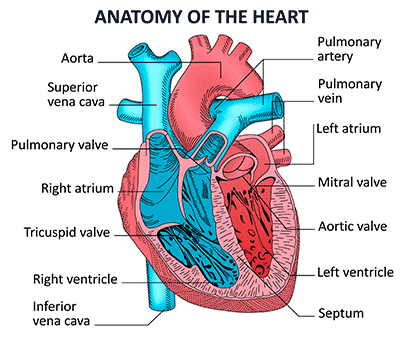Heart valve disease can be successfully treated and perhaps preventable

Cardiovascular disease is generally defined as the conditions that usually involve narrowed or blocked blood vessels that can lead to a chest pain, heart attack and stroke. Other heart abnormalities, such as those that affect heart’s muscle, valves or rhythm also refer to other forms of heart disease. In heart valve disease, one or more of the four valves in the heart do not properly function, either to close or to open. As a result, this condition causes the disruption of the blood flow through the heart to the body. If left untreated, it might lead to fatal complications such as sudden death. Although lifestyle modifications e.g. sufficient rest, proper food consumption and regular exercise might play a role in risk reduction of developing heart disease, being aware of warning signs and symptoms of heart valve disease and having annual heart check-ups help to receive appropriate and timely treatment as well as reduce serious complications that might develop.
Get to know “heart valves”
Four valves within the heart keep the blood flowing the right way by opening only one way and only when they need to. To fully work, the valves must be formed properly. They must open all the way and must close tightly thus no leakage is ensured. Heart valves regulate the direction of blood flow inside the heart which is a vital function. If they function improperly, blood circulation will be systemically affected, leading to life-threatening events.
The four valves consist of tricuspid valve, mitral valve, pulmonary valve and aortic valve. Each valve has flaps (leaflets or cusps) that open and close once during each heartbeat. If these valves do not open or close properly, it leads to the disruption of the blood flow through the heart to the body.

Signs and symptoms of heart valve disease
Although some patients with heart valve disease might not exhibit any symptoms for many years, common signs and symptoms of heart valve disease may include:
- Shortness of breath, particularly after activities or exertion
- Tiring easily or fatigue
- Frequent fainting
- Irregular heartbeat or abnormal sound of the heart
Types of heart disease
Heart valve disease may be present at birth (congenital). It can also occur in adults due to many causes and conditions such as infections, calcium deposits on the valve, valve flaps bulging back (regurgitation), valve flaps becoming thick, stiff or fuse together (valve stenosis) and other heart conditions that lead to improper valve functions and reduced blood flow through the valves.
Among four valves, mitral valve and aortic valve (left side of the heart) are the most common heart valve conditions due to high blood pressure that is required for pumping the blood to the whole body. High blood pressure is associated with increased risks of heart valve damages during each heartbeat. Heart valve regurgitation, or leaking heart valve refers to the condition when the valve flaps do not close properly, causing blood to leak backward in the heart. This commonly occurs due to valve flaps bulge back. it is a common disease found in the elderly, rather than children.
Diseases generated by heart valve disease
There are 3 main diseases involved including:
1. Rheumatic heart disease
Rheumatic heart disease is a condition in which the heart valves have been permanently damaged by rheumatic fever. Other affected areas are skin and throat. Rheumatic heart disease is a result of cardiac scarring triggered by an autoimmune reaction to infection with group A streptococci. The heart valve damages include scarring and calcium formation around the valves, resulting in malfunction of heart valve closing and opening. Eventually, the heart has to overwork start shortly after untreated or under-treated streptococcal infection.
2. Degenerative valve disease
This is a common cause of valvular degeneration. Due to advanced age, specially in patients aged over 40, valves can be degenerated and weakened. As a consequence, valves do not properly close or open. It commonly leads to heart valve regurgitation.
3. Coronary Artery Disease
The association of coronary artery disease with heart valve disease is frequently encountered. Myocardial infarction (heart attack) is a serious result of coronary artery disease. It might lead to heart valve regurgitation, especially found in patients aged 50-60.
Treatment of heart valve disease
Heart valve disease treatment entirely depends on the heart valve affected, the type and severity of the valve disease. Frequently, heart valve disease requires surgery to repair or replace the heart valve. Due to the advancements in technology, minimally invasive surgery helps enhancing surgical accuracy and promoting safety with smaller incisions, less pain and fewer complications as well as a faster recovery time and a quick return to daily life and activities.
There are 2 main options:
A minimally invasive aortic valve replacement is a surgery to replace a poorly working valve with an artificial valve. Based on artificial heart valves, there are 2 major types:
- Mechanical valve: These valves are made of strong durable materials. They are the most long-lasting type of replacement valve. However, patients always require a blood thinning medication throughout the remainder of their lives. The blood thinner keeps clots from forming, preventing clot lodging in the valve flaps or hinges and causing a valve malfunction.
- Biological valve (tissue valve or bioprosthetic valve) Biological valves are created from animal donors’ valves or other animal tissue that is strong and flexible such as cow and pig. Chances of having blood clot is considerably low thus long-term use of blood thinner medication is not required. However, biological tissue might potentially induce immune response to act against the valve, resulting in scar tissue and calcification. Eventually, valves might not be able to function properly.
More importantly, tissue valves can last 10-15 years. In patients with tissue valve replacement, the need for additional surgery or another valve replacement later in life is highly likely. While taking a life-time blood thinning medication required for mechanical valve replacement might result in a greater chance of bleeding, especially serious condition such as brain hemorrhage. For each surgery in which the valve must be replaced, careful considerations should be given to durability and medication options as well as possible risks.
Minimally invasive valve repair surgery is performed through a small incision, often using specialized surgical instruments. Valve repair can be performed to treat several conditions, including:
- Rheumatic heart disease: To remove the formation of calcium deposits and tissue scarring on the valve, repair techniques include excision of all inflamed or damaged tissue and repair of the missing tissue with fresh pericardial patch or primary suturing in order to preserve heart valve functions.
- Degenerative valve disease: Degenerative heart valves such as heart valve thickening, stiffening or enlarging can be successfully repaired.

Recently, new less invasive approaches for valve repair involve smaller incisions without cutting the breastbone. These minimally-invasive operations are performed with the use of specialized hand-held instruments. There is mounting evidence to suggest that, compared to patients undergoing heart valve replacement, these minimally-invasive approaches translate into less pain with a better treatment outcome, improved clinical symptoms such as shortness of breath and tiring as well as fewer complications that might generate by life-time prescription of blood thinning drugs.
More importantly, in order to achieve the best possible treatment outcomes, the vital factor regardless of surgery types is highly experienced and well-trained interventional cardiologist and cardiothoracic surgeons.
Supported by cutting-edge technology, hospital networking in national scale and world-class standard, Bangkok Heart Hospital is ultimately committed to provide comprehensive heart care to all patients including accurate diagnosis, effective and timely treatments as well as full recovery programs. In addition, we have conducted clinical researches and training involving in highly complicated heart conditions. By using patient-centric approach, patients can rest assured that they always receive appropriate treatments with the best possible outcomes.

